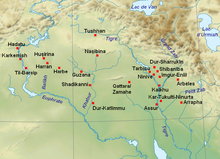Balawat
ܒܝܬ ܠܒܬ | |
 | |
| Location | Nineveh Governorate, Iraq |
|---|---|
| Region | Northern Mesopotamia |
| Coordinates | 36°13′46″N 43°24′12″E / 36.22944°N 43.40333°E on |
| Site notes | |
| Excavation dates | 1878, 1956, 1989 |
| Archaeologists | Hormuzd Rassam, M. Mallowan, D.J. Tucker |
Balawat (Template:Lang-syc, beṯ labat) is an archaeological site of the ancient Assyrian city of Imgur-Enlil, and modern village in Nineveh Province (Iraq). It lies 25 kilometres (16 mi) southeast from the city of Mosul and 4 kilometres (2.5 mi) to the south of the modern Assyrian town of Bakhdida.
Ancient name
Balawat is the site of the ancient Assyrian city of Imgur-Enlil. The meaning of Imgur-Enlil is "Enlil agreed". Note that there was also a wall in ancient Babylon named Imgur-Enlil.[1]
History of archaeological research

The site was excavated in 1878 by archaeologist Hormuzd Rassam.[2][3] The site was again excavated by Max Mallowan for the British School of Archaeology in Iraq in 1956.[4] A surface survey was conducted by D. J. Tucker in 1989 for the British Museum. The town walls enclosed an area of around 64 hectares.
Occupation history
The city of Imgur-Enlil was founded by the Neo-Assyrian king Ashurnasirpal II (884-859 BC). It lay 10 kilometres (6.2 mi) up the Derrah river from the Tigris, where the city of Kalhu (Biblical Nimrud/Calah) was situated. Imgur-Enlil lay between the major Assyrian cities of Nineveh and Arrapha (modern Kirkuk) in the southeast along the royal Assyrian road. Ashurnasirpal II had already transferred the capital from Assur to Kalhu, and the foundation of Imgur-Enlil may have been a further step to knit up the Neo-Assyrian empire. Construction at the site continued under Ashurnasirpal II's son Shalmaneser III. The city existed for about two and a half centuries but was, like most Assyrian cities, sacked and destroyed by the Medes, Babylonians and Scythians during the fall of the Assyrian empire 614-605 BC.
Post U.S.-Iraq War construction
In November 2004, the village had roads constructed by the United States Army, which connected the modern Assyrian village to the ancient Assyrian city of Kalhu and the village of Bakhdida (Al Hamdaniyah.) The project was dubbed "Ninewa Village Roads Project" and was funded by the U.S. government. The contract to build the roads was given to the Ashour General Construction Contracting Company and cost $1,120,000.[5]
Material culture

Aside from temples and palace buildings, the most important artifacts discovered there were the so-called Balawat Gates. The gates measured about 20 feet in height and belonged to the temple of Mamu, the god of dreams. These were made up of bronze bands attached through nails to two wooden gates of the palace. The bronze bands depict a sacrifice and war scenes from the campaigns of the Neo-Assyrian king Shalmaneser III (859-824 BC), and were the first depictions of landscape elements (such as trees and mountains) in Assyrian art.[6]
See also
References
- ^ Farouk N. H. Al-Rawi, Nabopolassar's Restoration Work on the Wall Imgur-Enlil at Babylon, Iraq, vol. 47, pp. 1-13,1985
- ^ Hormuzd Rassam, Excavations and discoveries in Assyria, In: Transactions of the Society of Biblical Archaeology, vol. 7, , pp. 37-58, 1882
- ^ Hormuzd Rassam and Robert William Rogers, Asshur and the land of Nimrod, Curts & Jennings, 1897
- ^ David Oates, Balawat (Imgur Enlil): The Site and Its Buildings, Iraq, vol. 36, no. 1/2, pp. 173-178, 1974
- ^ "Ninewa Village RoadsProject" (PDF). Archived from the original (PDF) on 2006-05-16. Retrieved 2006-05-13.
- ^ D. J. Tucker, Representations of Imgur-Enlil on the Balawat Gates, Iraq, vol. 56, pp. 107-116 , 1994
Further reading
- [1] Theophilus G Pinches and Walter de Gray Birch, The bronze ornaments of the palace gates of Balawat (Shalmaneser II, B.C. 859-825) edited, with an introduction by Walter de Gray Birch ; with descriptions and translations by Theophilus G. Pinches, Society of Great Russell Street, 1902
- Seton Lloyd, Foundations in the Dust, 1947
- J.E. Curtis et al., The Balawat Gates of Ashurnasirpal II, British Museum Press, 2008, ISBN 978-0-7141-1166-7
- Léonard W. King, Bronze Reliefs from the Gates of Shalmanezer. King of Assyria BC 860-825, Longman's & Company, 1915


